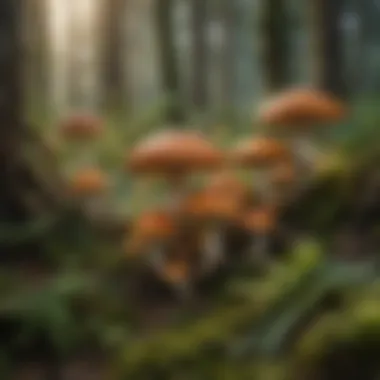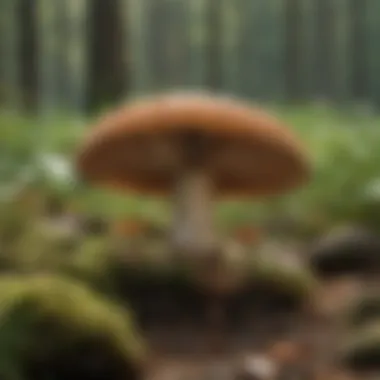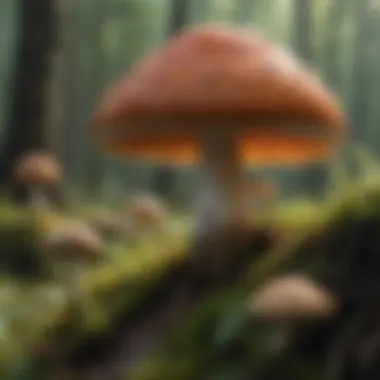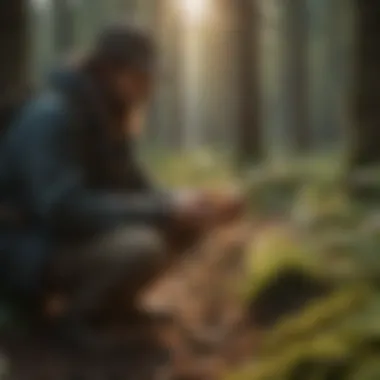A Guide to Online Mushroom Identification Resources


Intro
The pursuit of understanding fungi in our woodlands opens numerous doors to adventure and knowledge. In today's world, where information is at our fingertips, mushroom identification has become an intriguing activity for many. From seasoned foragers to newcomers eager to learn, accessing reliable online resources has grown tremendously.
This guide aims to delve into the intricacies of mushroom identification websites and how they can assist in navigating the rich tapestry of fungi. Not only is mushroom foraging a delightful way to engage with nature, but it also involves an appreciation for biodiversity and the ecosystems that sustain these organisms. As we journey into this fascinating realm, we will explore various online platforms that serve as pivotal tools for safe and informed foraging while highlighting their importance in fostering sustainable practices to protect our woodland environments.
By the end of this article, readers should emerge with a clear understanding of mushroom identification, the significance of community engagement, and the scientific approaches that reinforce safe foraging activities.
Prelude to Mushroom Identification
Mushroom identification is not just a mere hobby for enthusiasts; it stands as a crucial skill for anyone venturing into the world of foraging. The ability to accurately identify mushrooms can lead to rewarding culinary adventures or, conversely, to perilous and sometimes life-threatening consequences. Knowledgeable foragers possess a deep understanding of various mushroom species, their habitats, and the ecological roles they play. This understanding is key not only for individual safety but also for protecting our ecosystems, as the overharvesting of certain species can disrupt local biodiversity.
The Importance of Mushroom Identification
Navigating the intricate realm of fungi opens doors to both culinary delights and a richer appreciation for nature. The significance of correctly identifying mushrooms cannot be overstated, particularly for those eager to incorporate these unique organisms into their meals. With many species offering flavors that can elevate a dish, from the earthy depth of chanterelles to the robust richness of porcini, the culinary benefits are clear. However, the distinction between edible and toxic varieties is often razor-thin.
Take Amanita muscaria, for instance. Commonly known as the fly agaric, its striking red cap with white spots is an image that many might find irresistible. Yet, it's imperative to note that while this mushroom is iconic in folklore, it can cause severe toxicity if consumed improperly.
Understanding the taxonomy and morphology of mushrooms enables enthusiasts to make informed choices. When armed with proper identification skills, foragers can participate in a thriving community of mushroom gatherers, sharing knowledge and fostering a sense of camaraderie.
Potential Risks of Misidentification
While the allure of foraging presents an exciting opportunity, the risks associated with misidentifying mushrooms can be grave. Each year, there are reports of individuals experiencing serious health issues stemming from the consumption of poisonous fungi. The infamous Death Cap mushroom, scientifically known as Amanita phalloides, is one of the most lethal. Just a few bites can lead to liver failure and can be fatal without swift medical intervention.
Moreover, misidentification isn't just limited to individual health hazards. Inaccurate knowledge can contribute to ecological imbalances. Overharvesting a particular mushroom species due to misidentification may lead to its decline and disrupt the local ecosystem that relies on that fungus.
Here are some key points to consider regarding the risks of misidentification:
- Health Impact: Confusion between edible and toxic mushrooms can lead to poisoning.
- Conservation Issues: Misunderstanding of species can encourage practices that harm local biodiversity.
- Legal Consequences: In some areas, foraging mushrooms without understanding local regulations can result in fines or other legal repercussions.
"The true danger lies not in the act of collecting mushrooms themselves, but rather in the lack of knowledge surrounding their identification."
In essence, proper mushroom identification enriches the experience of foraging while safeguarding both the forager and the environment. This section serves to underscore the critical nature of this skill, paving the way for a more profound exploration into the resources and methods available for enthusiasts and professionals alike.
The Role of Online Resources
In today’s interconnected world, online resources have become essential tools for mushroom identification. These digital platforms not only provide a treasure trove of information but also facilitate communication among enthusiasts and experts alike. Whether you are a fresh face in foraging or have been at it for years, these resources enrich your understanding of fungi while offering a safer way to explore.
Mushrooms can vary dramatically, and relying solely on field guides can be limiting. Websites and applications that focus on mushroom identification offer conveniences that traditional methods often lack. They allow you to quickly search for species based on several criteria, compare images, and access real-time data from other users. The ability to pull up comprehensive databases at your fingertips can significantly enhance one’s foraging experiences.
In essence, the role of online resources extends beyond identification. They foster community engagement and collaboration among users, which amplifies learning and promotes ethical foraging practices. In this digital age, the importance of having reliable online tools cannot be overstated.
Advantages of Digital Identification Tools
Digital identification tools stand out because they often outpace traditional methods in flexibility and convenience. Their advantages may include:
- Instant Access to Information: With just a few taps, users can access a wealth of images, descriptions, and identification tips.
- Community Feedback: Many apps and websites feature forums or discussion groups where users can share their findings. This interaction can lead to immediate advice and corrections.
- Real-time Updates: Unlike printed materials, which can become outdated, online resources can quickly incorporate new discoveries or identification criteria.
Furthermore, the ability to upload images and ask for assistance from experienced foragers enhances the collective knowledge within the community. This immediate support can be invaluable for those unsure about specific characteristics of mushrooms they encounter.
Comparison of Websites and Applications


When evaluating various mushroom identification websites and applications, some key points emerge that can help users determine which resources align best with their needs:
- User Experience: A site that’s easy to navigate with clear categories and info is more friendly for beginners and experienced foragers alike.
- Richness of Database: Some platforms have extensive databases with high-quality images and scientific data, while others may lack detail. For instance, a site like Wikipedia could provide extensive baseline knowledge about various fungi.
- Mobile Compatibility: As many foragers enjoy mushroom hunting in the field, mobile apps that work without cell service can be a lifesaver.
- Community Engagement: Some platforms foster more community interaction than others, which can significantly enrich the learning process. Sites like Reddit have active communities sharing tips and experiences.
Key Features of Effective Identification Websites
When foraging for mushrooms, having the right tools at your disposal can be as crucial as knowing the difference between a safe edible and a potentially toxic variety. Websites dedicated to mushroom identification serve an essential purpose in this regard. They not only empower users with the knowledge necessary to recognize various fungi but also enhance the overall foraging experience. A good identification website will possess certain hallmark features that ensure users can navigate the often complex world of mushrooms effectively.
User-Friendly Interfaces
An effective mushroom identification website begins with usability. A user-friendly interface is paramount. It allows users to access information quickly and with least amount of hassle. Novices, in particular, may find themselves overwhelmed by technical jargon or complicated layouts. Clear categorizations based on characteristics like shape, color, and habitat can greatly improve the user experience. For instance, a website might employ a simple dropdown menu guiding users through various mushroom types based on their identifiable traits.
Important factors include:
- Clean Layout: Avoids clutter and distractions.
- Intuitive Navigation: Users shouldn’t need a manual to find what they’re looking for.
- Clear Search Function: A search bar that returns relevant results quickly can save time and frustration.
Access to Comprehensive Databases
A valuable mushroom identification resource should have a rich and extensive database. The more mushrooms a website covers, the better chance users have of successfully identifying their finds. This means both common and rare species should be represented. Furthermore, it is essential that the information presented is accurate and well-researched. Websites that offer access to scientific data, such as habitat preferences and ecological interactions, add an extra layer of depth.
Several websites curate databases that include:
- Species Descriptions: In-depth information about individual mushrooms.
- Geographic Distribution: Know where to find particular types in the wild.
- Ecological Roles: Insight into the environmental significance of different fungi.
Visual Aids and Identification Guides
Nothing beats the power of visual aids when it comes to identifying mushrooms. Photographs, illustrations, and even videos can significantly enhance understanding. High-quality imagery showing the mushroom from multiple angles helps users recognize specific features, such as gills, caps, and stems. A website featuring a visual catalog, combined with interactive identification tools, can turn a daunting task into a more approachable one.
Key components to look out for include:
- High-Resolution Images: Clear pictures that showcase details like texture and color variations.
- Identification Checklists: User-friendly guides that lead novice foragers step-by-step through identifying a species.
- Interactive Quizzes: Fun tools that test knowledge on mushroom characteristics and habitats.
"Engaging with details and visuals can transform mushroom foraging into an enjoyable, rather than an intimidating, activity."
In summary, the key features of effective mushroom identification websites encompass user-friendly interfaces, comprehensive databases, and rich visual aids. These attributes not only benefit novice foragers but also serve seasoned enthusiasts looking to deepen their understanding of fungi. By selecting resources that embody these principles, users can improve their chances of safe and sustainable foraging.
Critical Components of Mushroom Identification
Mushroom identification can often feel like deciphering a thrilling mystery. Understanding the critical components involved is essential, as it not only enhances the forager's experience but also improves safety and encourages responsible practices in the wild. Each element plays a vital role, leading to a more informed and beneficial interaction with these captivating organisms.
Morphological Characteristics
Morphological characteristics are like the fingerprints of a mushroom. Each species possesses unique physical traits. This includes the size, shape, color, and texture of the cap, stem, and gills, which help in distinguishing one fungus from another. For instance:
- Cap Shape: Some caps might be convex, others flat or shaped like a bell. A change in cap morphology can indicate different readiness for spore release.
- Gills vs. Pores: Understanding whether a mushroom has gills or pores is crucial. For example, Russula species have gills, while Boletus has pores. That distinction can save a forager headache later.
- Veils and Rings: Some mushrooms feature a ring around the stem or remnants of a veil. This can indicate certain types, such as the infamous Agaricus bisporus, or the common button mushroom we see in supermarkets.
Visual aids like charts and photographs on mushroom identification websites become invaluable in recognizing these traits. When a forager can swiftly identify and compare these characteristics, the entire experience becomes more rewarding.
Habitat and Ecological Context
The habitat is another key factor in mushroom identification. Different mushrooms thrive in specific settings. Observing where a mushroom grows is just as important as knowing what it looks like. Some points to consider include:


- Soil Type: Certain fungi prefer sandy soil, while others delight in rich, loamy earth. For instance, Lactarius mushrooms often grow under conifer trees, thriving in acidic soil.
- Association with Trees: Many mushrooms depend on a symbiotic relationship with trees. Mycorrhizal fungi, like Cantharellus cibarius, often indicate the presence of nearby oak or pine trees.
- Environmental Conditions: Factors like moisture levels and light conditions also dictate fungi growth. Mushrooms may pop up in damp forest floors or meadows where light filters through thick canopies.
Mushroom identification websites often provide useful data and visuals about specific habitats, enhancing a user’s ability to spot fungi while out in the field.
Seasonality and Timing
Fungi are seasonal organisms, much like flowers. Different species will flourish during various parts of the year. Knowing the seasonal patterns is vital for anyone wanting to forage mushrooms responsibly. Key elements to consider include:
- Spring Awakening: Some mushrooms, like Morchella (morels), herald the arrival of spring. This is the time when they burst forth, typically around April or May in temperate regions.
- Autumn Abundance: Fall often brings an explosion of fungi, such as Armillaria mellea, or honey mushrooms, that thrive during cooler, damp conditions.
- Winter Wonders: Some fungi can even survive the cold, such as Auricularia auricula-judae, which may pop up on trees even in winter.
Timing one's foraging efforts in alignment with both the season and specific local conditions vastly improves the chances of successful identification and gathering. Remembering growing seasons is crucial, as it allows individuals to not just forage smarter but also safer.
"Identifying mushrooms is not just an art; it's a science woven into the fabric of nature's tapestry."
Understanding these critical components—morphological traits, habitat preferences, and seasonal timings—forms the backbone of mushroom identification. As the world of fungi continues to unravel its mysteries, embracing these components promotes a meaningful relationship with both the species and the ecosystems supporting them.
Building a Community of Foragers
In the realm of mushroom identification, fostering a vibrant community of foragers is not just beneficial; it is essential. The process of identifying and gathering fungi can be fraught with uncertainties, and having a support system can significantly enhance one’s expertise and confidence. Communities provide a platform for knowledge sharing, learning from collective experiences, and best practices that are vital for responsible foraging.
A community of foragers connects individuals with diverse backgrounds, all possessing unique insights about local species and foraging techniques. From friendly amateurs to experienced mycologists, each member can contribute to a wealth of shared knowledge. This collective intelligence can help newcomers avoid pitfalls, as seasoned foragers can demystify the complexities of identification and eco-friendly practices.
Moreover, communities often establish networks that facilitate group forays, where members can learn from one another in the field. Nothing beats hands-on experience when it comes to identifying mushrooms; the guidance of a knowledgeable peer can turn a potentially risky encounter into a successful learning moment.
"In nature, nothing is perfect and everything is perfect. Trees can be contorted, bent in weird ways, and they're still beautiful." - Alice Walker
Forums and Discussion Groups
Online forums and discussion groups serve as digital meeting grounds for mushroom enthusiasts, allowing participants to share tips, ask questions, and discuss findings. Sites like Reddit have dedicated subreddits such as r/mycology and r/shrooms where foragers congregate to explore various topics around mushrooms. Participating in these platforms can greatly enhance a forager's knowledge base.
- Shared Experiences: Users can discuss their personal experiences regarding specific mushroom species. These narratives can provide valuable context that textbooks may lack.
- Real-Time Feedback: Forums offer immediate interaction, helping users receive quick guidance on identification or advice on local regulations.
- Diversity of Perspectives: Engaging in discussions with members from various regions allows foragers to learn about mushrooms they may never have encountered in their local area.
User-Generated Content and Reviews
The influence of user-generated content in the mushroom identification space cannot be overstated. It allows individuals to share their findings, identify local mushrooms, and contribute to reviews of identification tools and apps. Instead of relying solely on academic resources, foragers can benefit from insights provided by actual users who have encountered specific conditions or species in the field.
- Authenticity and Trust: User-generated reviews provide authenticity that is often lacking in commercial tools. When users publish their findings and rate identification applications, it builds a sense of trust for future foragers deciding on which resources to utilize.
- Visual Aids: Many contributors post photographs of their finds alongside descriptions. This visual content can help facilitate accurate identifications, particularly for those unsure about the subtle differences between similar-looking species.
- Continuous Learning: As mushrooms vary dramatically depending on location and season, user-generated content helps compile up-to-date information that traditional texts may not convey.
In summary, building a community of foragers enriches the ecosystem of mushroom identification. By engaging in forums, sharing user-generated content, and exchanging knowledge and experiences, both novices and seasoned enthusiasts can deepen their understanding of fungi while forging connections with like-minded individuals.
The Intersection of Science and Foraging
The vast world of fungi offers both wonder and complexity. In this intersection of science and foraging, we find a rich landscape where knowledge from mycology mingles with the practical expertise of foragers. This relationship is crucial not just for increasing our understanding of mushrooms, but also for promoting safe and sustainable practices when interacting with nature’s diverse offerings.
Scientific rigor lends credibility to the often subjective art of foraging. By utilizing resources grounded in mycological research, individuals can deepen their knowledge, appreciate ecological balances, and improve their foraging skills. A growing body of research enables foragers to make informed decisions, ensuring that their activities do not disrupt delicate ecosystems. The science behind fungal growth, identification, and ecological roles enhances the experience for both amateur and seasoned foragers alike.
Role of Mycology in Online Resources
Mycology, the study of fungi, plays a pivotal role in the development of online resources for mushroom enthusiasts. High-quality websites and applications often collaborate with mycologists to provide accurate and detailed information regarding mushroom species.
- Identification Accuracy: Many online platforms integrate scientific data and expert input to enhance identification accuracy, ensuring users can distinguish between edible and poisonous varieties.
- Current Research: As new species are discovered and classifications are updated, reputable sites frequently change their databases to reflect the latest findings.
- Educational Content: Articles, videos, and webinars hosted on these platforms provide valuable insights into fungal life cycles, habitats, and uses in medicine and cuisine.


Having access to scientifically-backed information fosters a more responsible foraging community. By understanding the biology and ecology of fungi, foragers are better equipped to respect natural habitats and adhere to sustainable practices.
Data Collection and Citizen Science
The burgeoning field of citizen science has gained traction particularly in mycology—an intersection amplifying both data collection and community engagement. Many mushroom enthusiasts contribute valuable observations that enhance scientific understanding of fungi.
"Citizen science empowers individuals to become active participants in ecological research and conservation efforts."
Participation in these data collection efforts offers several benefits:
- Expanded Databases: Contributions from foragers help build extensive databases that researchers can rely on for studies concerning distribution, abundance, and seasonality of various species.
- Local Insights: Localized observations offer insights into fungal populations that might not be reflected in formal studies, revealing previously uncharted areas of diversity.
- Awareness and Education: By engaging with scientific research, foragers become more informed about local ecosystems, fostering a deeper appreciation for biodiversity.
Ethical Considerations in Foraging
Understanding the ethical implications behind foraging is indispensable for anyone engaging in the world of fungi. As with any interaction with the natural world, one must tread lightly to ensure the preservation of ecosystems and respect for communal resources. The balance of ecological sustainability and personal enrichment is a tightrope that every forager should navigate carefully.
For instance, practicing responsible foraging not only benefits the environment but also enhances one’s personal experience. It creates a closer bond with nature, fosters a deeper appreciation for biodiversity, and allows for the cultivation of skills necessary for sustainable practices. High-quality mushroom identification websites often advocate for these ethical considerations, making them essential reading for both novices and experts.
"Ethical foraging is not just about taking what is plentiful; it's about ensuring future generations can also enjoy the fruits of the earth."
Sustainable Harvesting Practices
Sustainable harvesting is at the heart of ethical foraging. When gathering mushrooms in the wild, it’s crucial to take only what you need and leave enough behind to allow for regrowth. An often overlooked aspect is understanding the life cycle of the fungi. Many species have intricate relationships with their environment. For example, some mushrooms grow symbiotically with certain trees, thus removing them can jeopardize future generations of both plants and fungi.
Here are some vital tips for sustainable practices:
- Know the species: Always ensure that you can positively identify the mushroom before picking it. Some look-alikes can be harmful to the ecosystem.
- Limit your harvest: As a rule of thumb, take no more than one-third of any given patch.
- Use proper techniques: Gently twist or cut the mushroom at the base to avoid disturbing the underlying mycelium.
- Timing is key: Forcing growth by over-harvesting can deplete resources faster than they can replenish.
Legal Regulations and Restrictions
Understanding the legal landscape surrounding foraging is just as essential as operational knowledge. Different regions have specific regulations that dictate where and how foraging can be conducted. Being aware of these laws protects the environment and fosters community trust. For instance, some national parks have areas designated for foraging, while others beautifully prohibit it altogether. Ignoring these regulations could result in hefty fines or worse.
It’s prudent to consult local guidelines before heading into the woods. For example:
- Permits: Some jurisdictions require permits for foraging certain species, like wild mushrooms, due to their ecological importance.
- Restricted Areas: Areas like nature reserves might have strict no-collecting policies to protect native species.
- Educating Others: Share information about legal regulations within foraging communities to promote responsible practices.
By being mindful of these ethical considerations, individuals contribute to a more sustainable and legally compliant approach, ultimately ensuring a rich foraging experience for everyone involved.
Finale: The Future of Mushroom Identification
As we stand on the cusp of a new age in mycology, the future of mushroom identification seems brighter than a sun-drenched forest floor. This transformation is driven not only by advancements in technology but also by a growing awareness of the delicate balance within our ecosystems. The ability to identify and understand fungi contributes not just to individual safety but also to the broader objective of sustainable foraging practices.
Emerging Technologies in Mycology
Innovative technologies are reshaping how we identify and learn about mushrooms. Imagine the practicality of smartphone applications utilizing artificial intelligence to analyze photos of fungi. This technology can assess various characteristics such as cap shape, color, and size, providing immediate feedback to users. Such tools can be a game changer for both novices and professionals alike, drastically reducing the margin for error.
Moreover, the integration of augmented reality is making its mark. Picture this: you’re walking through a lush forest and can easily pull up a virtual overlay showing detailed information about any mushroom you encounter, all through your camera lens. These futuristic tools might seem like science fiction, but they’re well within reach. The lessons learned from ongoing research and development promise more accurate identification tools, enabling foragers to make informed choices swiftly.
The Role of Education in Fungal Studies
Looking ahead, education plays a pivotal role in fostering a culture of informed foraging. The advent of online courses and webinars focused on mycology can elevate public understanding. Such resources help demystify this complex field, from the basics of fungal biology to advanced identification techniques. As people become more educated about fungi, they become more conscientious about their impact on the local environment.
"The only limit to our realization of tomorrow will be our doubts of today."
- Franklin D. Roosevelt
Furthermore, community engagement through social media platforms like Reddit and Facebook cultivates a shared space for learning. Discussions and shared experiences can highlight not only successful identification stories but also cautionary tales of misidentification. This peer-to-peer learning fosters a deeper connection to mycology.
In summary, the future of mushroom identification navigates a path where technology meets education. With the right tools and knowledge, we create a generation of foragers equipped to appreciate and protect the intricate web of life that mushrooms contribute to our ecosystems.







